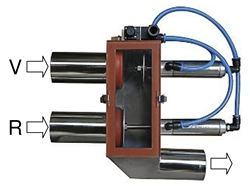
Comparing Blending Alternatives
You have several choices when it comes to how you will introduce materials into a blend suitable for your processing requirements. Oddly enough, the method that seems least expensive may be the most expensive in the long run so you need to examine the choices carefully to see what is best for your operation.
Scoop & Weigh
The “scoop & weigh” method is labor intensive and typically a very inaccurate process, meaning that you have no real control over your blending costs or accuracy. Human error can run rampant. Typically, colorants are used in higher quantities than necessary, leading to higher costs than necessary but what if colorants or performance additives are shorted? Then, product performance and appearance can vary greatly – leading to dissatisfaction among customers.

Summary:
- Lowest initial investment
- Labor intensive
- High level of errors
- No mixing unless a machine-mounted mixer is used
- Excessive use of high-cost additives
- Poor quality control
- High reject rate
- Customer dissatisfaction
Buy Pre-Mixed/Custom Compounded Material
Purchasing all materials pre-mixed or custom compounded is not only costly but you are putting the blending of your ingredients into the hands of a supplier over whom you have no control. Typically, you are investing in high volumes of a number of unique materials that require extensive inventory space and record keeping. Plus - changes in your process or material needs requires extensive planning and testing of revised material formulations.

Summary:
- No equipment investment
- Highest material cost
- Highest level of material inventory
- Ingredient blending out of your control
- High level of record-keeping
- Specification change may stick you with unused material
- Extensive testing required for changed formula
Proportional “Mixing” Valves
Proportioning valves are attached to self-contained loaders or to vacuum receivers (in a central resin conveying system). They have two valves that are timed to open and close to layer materials into the loader or receiver as it is loaded by vacuum. They are typically used to introduce some approximate percentage of regrind into virgin material, but they are actually best suited for simply allowing the consumption of regrind generated during processing. No real mixing takes place unless you install a separate mixer. This works if the appearance and properties if your end product are not critical and if your process can tolerate all of the regrind generated, as it is generated. But, results of this type of “blending” is extremely erratic and should be avoided if quality control is important in your process and products.

Summary:
- Low equipment investment
- May be OK to introduce regrind if product quality and appearance not critical
- Timed material proportions are approximate
- No mixing unless machine mount mixer used
Cascading “ Blenders”
Cascading blenders depends on the feeding of ingredients, usually from up to four hoppers, into a series of angled chutes. As the ingredients fall through the chutes, they intermingle to become “blended”. The materials are metered into the chutes using either vibratory or screw feeders but since there is no weighing of the ingredients and therefore little control over the actual blending, the system is victim to all of the inaccuracies of any volumetric blending process. Only the mixing section is simplified through the use of a cascading system, vs. a powered, typically rotating mixing section.
Summary:
- Moderately low equipment investment
- Gravimetric blenders feed ingredients by volume
- Inaccurate feed rates result in product defects
- Inaccurate feed rates increase additive costs
- Mixing is haphazard using cascading method

Dosers
A Doser, also referred to as a Feeder is designed to introduce minor ingredients into the flow of a main ingredient at the throat of a processing machine. Common components include a throat adaptor, mounted below the machine’s main material supply hopper, a speed-adjustable DC motor connected to a metering auger and a machine interface control. Dosing is controlled either by a trigger signal from an injection molding machine or it may operate continuously with its speed is governed by the extruder it feeds.
Volumetric dosers rely solely on free flowing materials and careful calibration to achieve a modest level of accuracy.
Gravimetric dosers typically operate in a ‘loss of weight’ mode to accurately monitor and continuously correct the desired dosing level by measuring the weight of the additive supply hopper.

Dosers typically do not provide any mixing to the combination of materials that they create, unless a separate machine-mounted mixer is added below, or in place of its throat adaptor.
Summary:
Moderate equipment investment
Volumetric dosers:
- Relatively inaccurate
- For free flowing materials only
- Operate on time, to introduce approximate volume of material
- Increased labor costs due to tweaking of dispense rates
- Inaccurate feed rates result in product defects
- Inaccurate feed rates increase additive costs
Gravimetric dosers:
- High accuracy of ± 0.1%
- “Loss in weight” method reduces material costs and rejects
- Can dose materials with poor flow characteristics
- Accessories available for difficult materials
Volumetric Blenders

Typically OK if the proportions of regrind and additives are not critical to the quality or appearance of your end product. May consist of two or more volumetric feeders mounted over a bin with or without a mixer. Sometimes material falls through a cascading “blender” (see picture). The image shows two feeders attached to a “cascading blender” (see above). There is no weighing of components.
Each component of the blend must be calibrated to assure a working knowledge of volume to weight ratios for properly setting up the blender. Volumetric blenders are basically timing devices that assume a certain volume of an ingredient, added over time will yield a certain weight in the mix. This is typically inaccurate to some degree. Using more virgin or more additives than necessary impacts product cost, quality and decreases profitability.
Summary:
- High investment, considering its marginal accuracy
- Depends on timed dispensing of free-flowing materials
- Increased labor costs due to tweaking of dispense rates
- Relatively low accuracy
- Poor control over material costs
- Higher reject rates
- May be useable where product quality not critical
Gravimetric Blenders

Gravimetric blenders hold batch weight to within ± 0.1%, by weight, so you can rest assured that ingredient proportions are uniform. In addition, once set up, and the recipe is entered, most gravimetric blenders automatically calibrate and run “hands-free” to ensure proper proportions and mixing of ingredients. Advanced controls allow complete documentation of the blending process as a further level of quality control.
The results of using gravimetric blenders are dramatic.
Summary:
- Highest initial cost
- Quick recovery of investment costs
- Hands-free operation reduces labor costs
- Gravimetric dispensing within ± 0.1%, by weight
- Significant reduction of additive costs
- Increased product quality and customer satisfaction
- Faster changeover times with removable hoppers
- Machine mount units reduce floor congestion
- Advanced controls provide complete documentation



